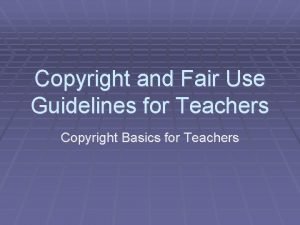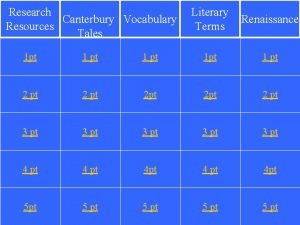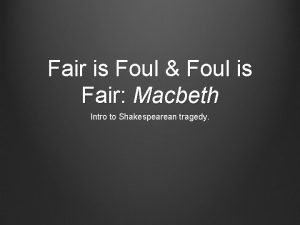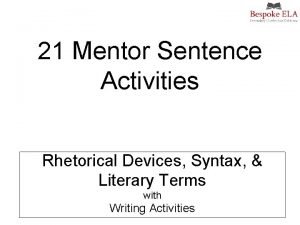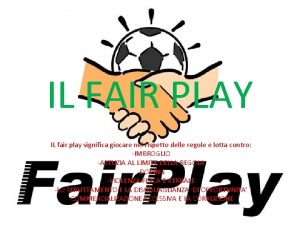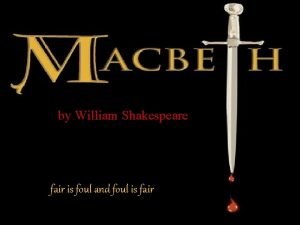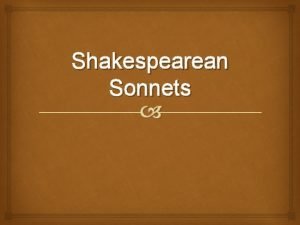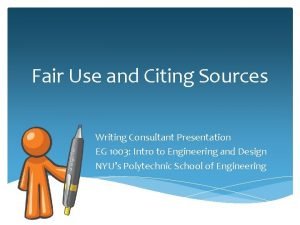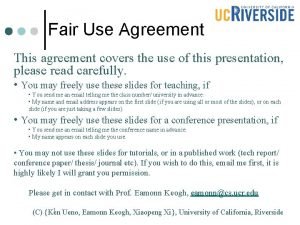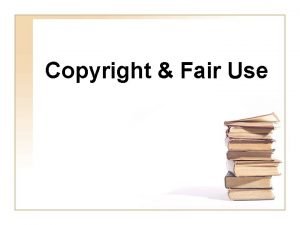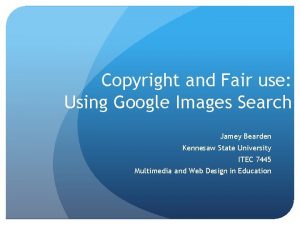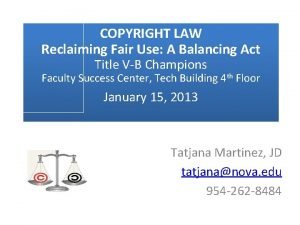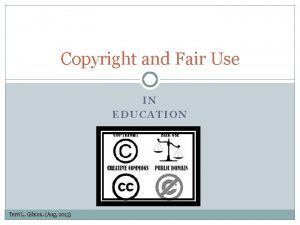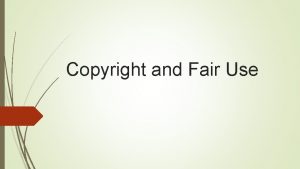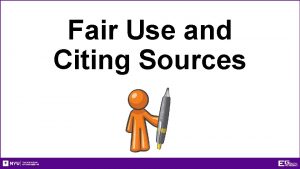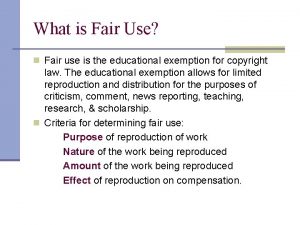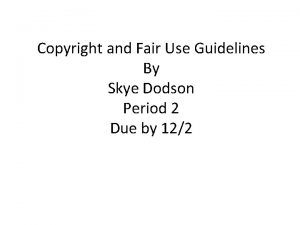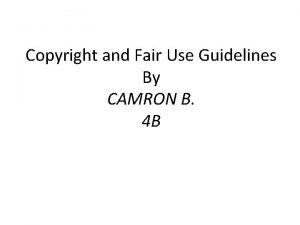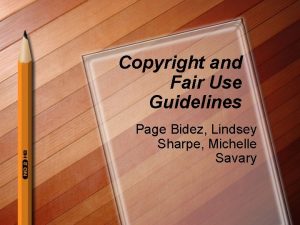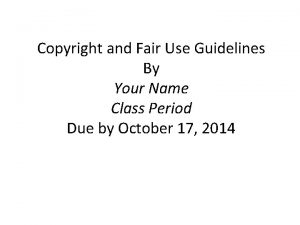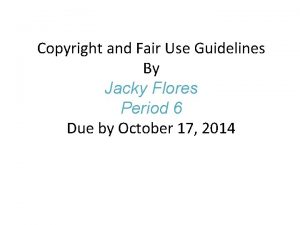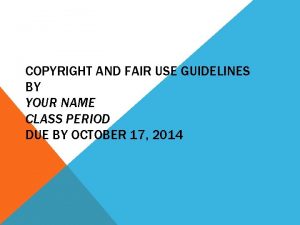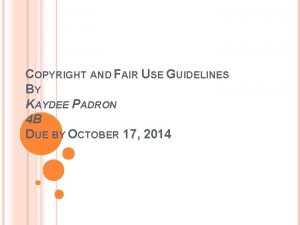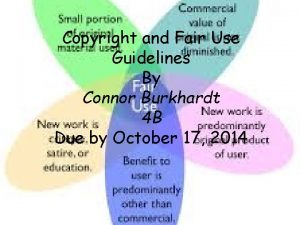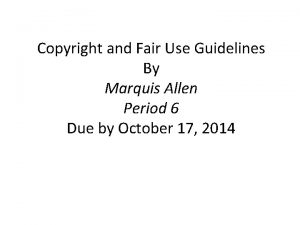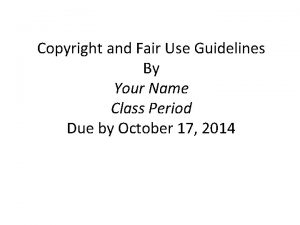THE COPYRIGHT LAW and Fair Use Guidelines for


















- Slides: 18

THE COPYRIGHT LAW and Fair Use Guidelines for Educational Multimedia

COPYRIGHT LAW Laws designed to protect intellectual property rights and provide potential monetary rewards for inventiveness and hard work. � The ease with which material can be copied, digitized, manipulated, incorporated into a presentation and delivered to a mass market has prompted a concern about the adequacy of copyright laws as they apply to the multimedia industry.

COPYRIGHT ACT OF 1976 Protects certain kinds of “original works of authorship”—whether published or unpublished Protects works “fixed in any tangible form of expression”

THE COPYRIGHT LAW COVERS. . . Literary works (books, poems, software) Musical works, including any accompanying words Dramatic works, including any accompanying music Pantomimes and choreographic works Pictorial, graphic, and sculptural works Motion pictures and other audiovisual works Sound recordings Architectural works

DOES NOT COVER. . . Ideas Facts Titles Names Short phrases Blank forms

TRADEMARKS ©RIGHTS ARE DIFFERENT A trademark is a name, symbol, or other device identifying a product Trademarks are not covered by the copyright law, but by the Trademark Law Trademarks are frequently marked with a registered trademark symbol--® � Example: Coca Cola ®, Nike®

HOW DO I OBTAIN A COPYRIGHT? You automatically own the copyright to any work you create as soon as it is fixed in a tangible medium. You can indicate ownership by using the expression “copyright by” or the © symbol. You can register for ownership with the U. S. Copyright office; this does provide you with additional legal benefits.

EXCEPTION TO OWNERSHIP In the case of works made for hire, the employer and not the employee is considered to be the author. Section 101 of the copyright law defines a “work made for hire” as: �A work prepared by an employee within the scope of his or her employment; or � A work specially ordered or commissioned for use

RIGHTS OF THE OWNER You have the right to: � Reproduce the work � Distribute copies of the work � Make a “derivative” work (make copies or changes from the original) � Publicly perform the work � Put the work on public display If you perform any of these tasks and are NOT the copyright owner, you are infringing on their rights. � Example: copying software, sharing MP 3 files, photocopying, uploading materials to websites, etc.

WHAT OPTIONS DO WE HAVE? Fair Use Guidelines for Educational Multimedia Public Domain Royalty-Free Products

FAIR USE GUIDELINES Portions, or in some cases the entirety, of copyrighted works may be used Legitimate uses include “criticism, comment, news reporting, teaching, scholarship, or research. ”

FAIR USE FACTORS For use to fall under the Fair Use guidelines, the following factors must be considered: � Purpose and character of use—commercial or non-profit educational purposes � The nature of the copyrighted work � The amount and substantiality of the portion used � The effect of the use upon the potential market value of the product

FAIR USE LIMITATIONS Motion media 10% or 3 minutes, whichever is less Text material 10% or 1000 words, whichever is less Music 10% or 3 minutes, whichever is less Photographs / 5 images per photographer/ artist; 10% or 15 images from a collective work Illustrations

CREDIT YOUR SOURCES “Educators and students are reminded to credit the sources and display the copyright notice and copyright ownership information. . ”

PUBLIC DOMAIN Property rights that belong to the community at large, are unprotected by copyright or patent, and are subject to use by anyone � You should have documentation that the item is in public domain before using it Anything published before 1923 Anything created by the U. S. Federal Government Public domain is not the same as freeware or shareware: • Freeware: software that is provided without a charge • Shareware: copyrighted software that is available free of charge on a trial basis

ROYALTY-FREE Prepared material that can be used—legally— without paying a fee to the artist, publishing company, etc. Some royalty-free material is available at no cost; however, most material must be purchased. Royalty-free doesn’t necessarily mean FREE —you may have to pay for it.

REMEMBER. . . Credit your sources! When you create a work, you own the rights to that work. Creating projects for the classroom is not necessarily the same as creating projects for competition—know the guidelines.

REMEMBER. . . It is permissible to download limited amounts of material for use in a student project, but you can’t download material from one web site and post it to yours. Know that royalty-free doesn’t mean unlimited rights —but it does expand your options There is a difference in personal use, educational use, and the workplace.
 Copyright and fair use guidelines for teachers
Copyright and fair use guidelines for teachers Music copyright fair use
Music copyright fair use Foul is fair and fair is foul literary device
Foul is fair and fair is foul literary device Literary terms in macbeth
Literary terms in macbeth Fair is foul and foul is fair macbeth
Fair is foul and foul is fair macbeth What is syntax rhetorical device
What is syntax rhetorical device Fair play significato
Fair play significato Examples of fair is foul and foul is fair in macbeth
Examples of fair is foul and foul is fair in macbeth Shakespearean sonnet
Shakespearean sonnet Newton's first law and second law and third law
Newton's first law and second law and third law Newton's first law of motion
Newton's first law of motion Boyle's law charles law avogadro's law
Boyle's law charles law avogadro's law How to calculate boyle's law
How to calculate boyle's law Fair use definition
Fair use definition Fair use
Fair use Fair use definition
Fair use definition Google images fair use
Google images fair use 4 factors of fair use
4 factors of fair use 4 factors of fair use
4 factors of fair use
